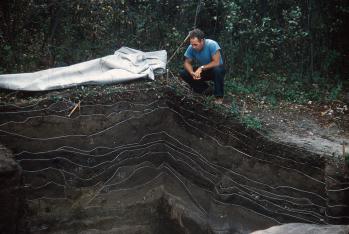
Boyd Wettlaufer was born in 1914 at Asquith, Saskatchewan and raised in Bracebridge, Ontario. He became interested in archaeology as a youngster. While serving with the RCAF during World War II, he visited the National Museum of Canada in Ottawa and, learning that professional archaeology was poorly developed throughout the country and virtually non-existent in the west, was encouraged to get the proper training in the discipline. Following the war he enrolled at the University of New Mexico, where he majored in archaeology and minored in geology before returning to Canada for fieldwork. His important 1951 report for the National Museum described the location and contents of 202 sites, listed the names of 324 collectors, and assessed the general state and potential for archaeology in southern Saskatchewan. During the early 1950s he directed a landmark excavation at the Mortlach site, generating several firsts for Canadian archaeology: first use of the radiocarbon dating method (seven cultures dated between 1445 BC and AD 1780); first use of the multidisciplinary approach; and first naming of archaeological cultures on the prairies. His subsequent excavations at the Long Creek site in 1957 extended the northern plains archaeological record by another 1,500 years, to 3000 BC.
Boyd Wettlaufer's pioneering contributions to prairie archaeology have remained of fundamental importance for more than fifty years. In 2004, he was invested as a Member of the Order of Canada, and was awarded an honorary life membership by the Saskatchewan Archaeological Society. In 1983 the Society dedicated to him its book, Tracking Ancient Hunters, with the recognition that he “lifted Saskatchewan archaeology out of the realm of speculation and placed it on a firm foundation.”
Ian Dyck